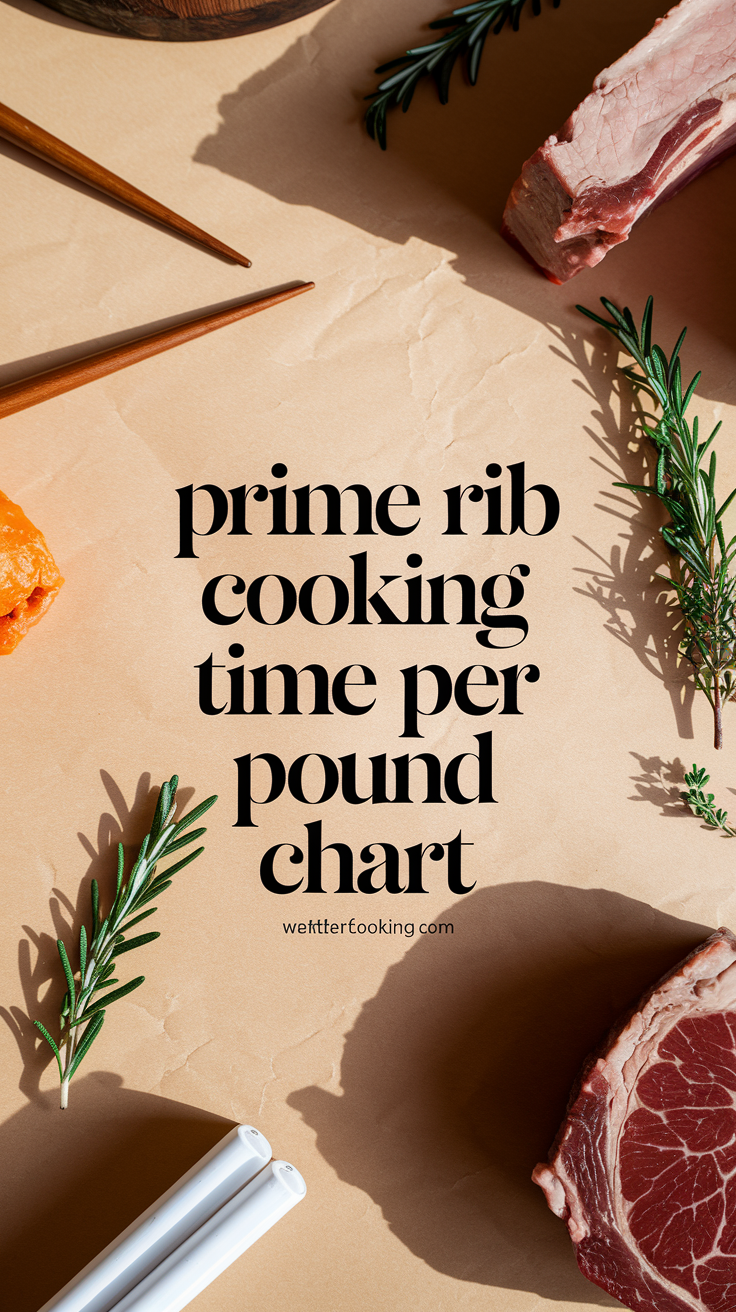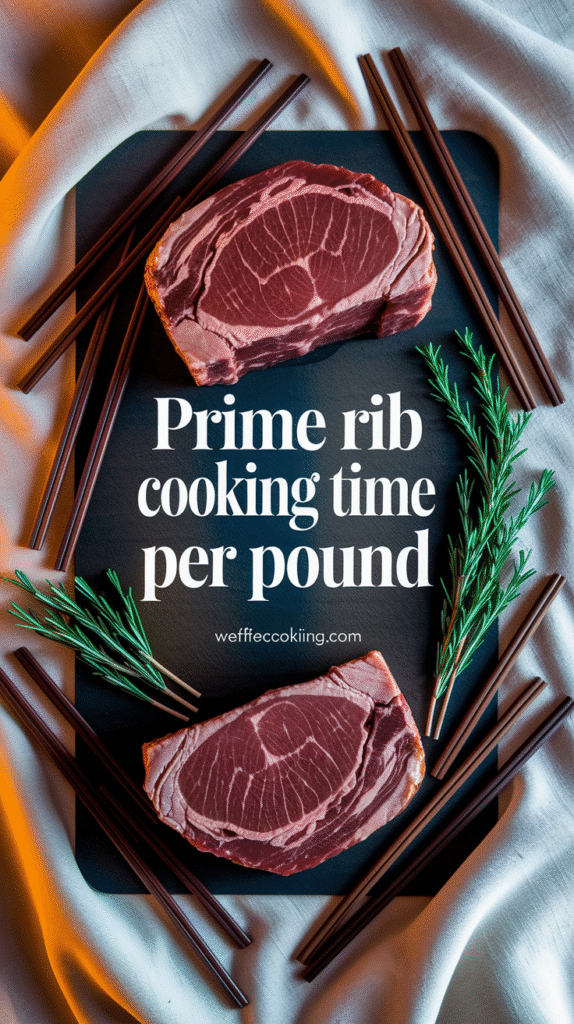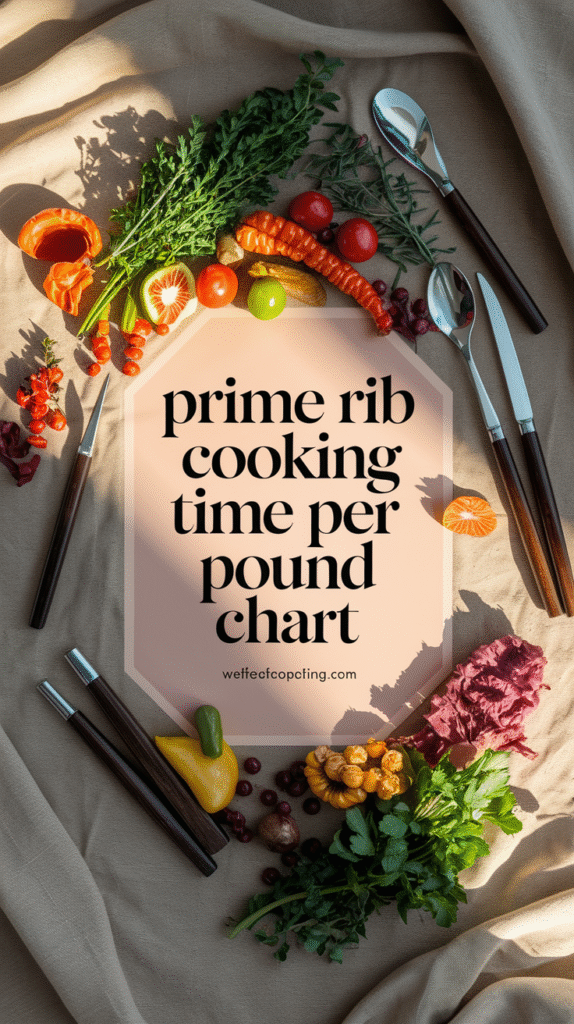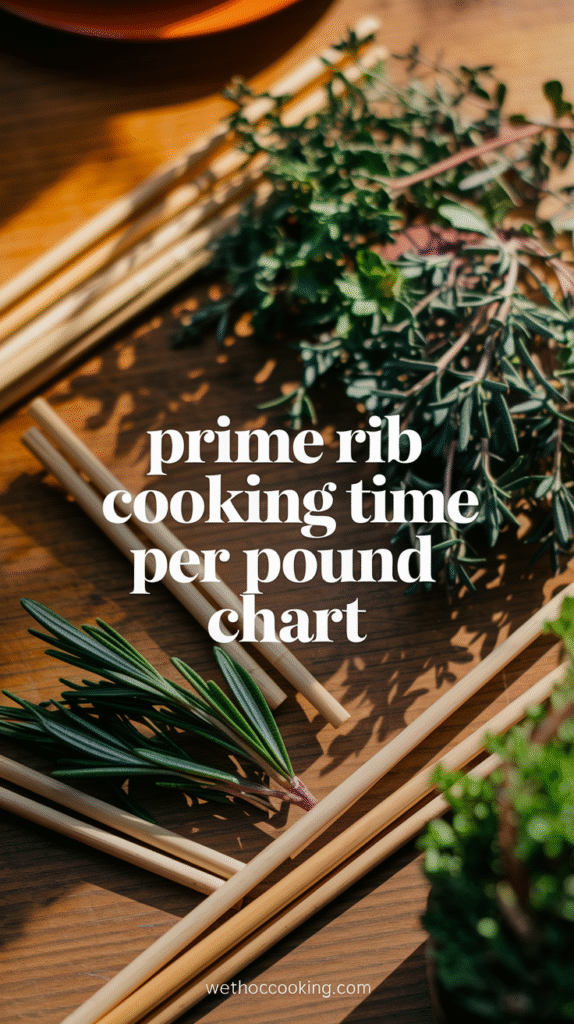If you’re planning a special dinner or holiday feast, prime rib is a popular choice that never disappoints. However, knowing how long to cook this delicious cut can be tricky. That’s where understanding the prime rib cooking time per pound chart plays a vital role. With the right information, you can serve a perfectly cooked prime rib that will impress your guests.
To find the ideal cooking time for prime rib, you’ll want to consider a few factors. The size of the roast, the desired level of doneness, and the cooking method all play important roles. Here’s a complete guide to help you navigate through it.
Here’s a simple chart showing the cooking times per pound based on the doneness levels:
| Doneness Level | Temperature (°F) | Cooking Time Per Pound (minutes) |
|---|---|---|
| Rare | 125°F | 15-20 minutes |
| Medium Rare | 135°F | 20-25 minutes |
| Medium | 145°F | 25-30 minutes |
| Medium Well | 150°F | 30-35 minutes |
| Well Done | 160°F | 35-40 minutes |
To successfully use this chart, begin by determining the weight of your prime rib. Next, decide how you prefer your meat cooked, and then refer to the chart for the appropriate cooking time. It’s important to note that these times are estimates and can vary depending on your oven and specific roast size.
Before cooking, it’s crucial to let your prime rib come to room temperature. This step helps achieve even cooking. Allow the meat to rest for about 2 hours after removing it from the refrigerator.
In addition to time and temperature, another important aspect to consider is the cooking method. Whether you plan to roast, grill, or smoke the prime rib can affect cooking times. Here’s a brief overview of popular methods:
- Roasting: The most common method, using an oven to evenly cook the meat.
- Grilling: Provides a wonderful smoky flavor and sear on the outside of the roast.
- Smoking: Slow cooking on a smoker at low temperatures for a tender, juicy result.
Regardless of the cooking method, using a meat thermometer is essential for accuracy. Insert it into the thickest part of the roast, avoiding bone or fat. This way, you can monitor the internal temperature closely, ensuring that your prime rib comes out perfectly. For a suitable place to get quality meat thermometers and cooking tools, visit ThermoWorks.
After cooking, let your prime rib rest for about 15 to 30 minutes before slicing. Resting allows the juices to redistribute, leading to a more flavorful and juicy cut. During this time, it’s also helpful to cover the roast with aluminum foil to keep it warm.
Prime rib is best served with classic sides like mashed potatoes, Yorkshire pudding, or seasonal vegetables. Consider adding a rich gravy or horseradish sauce to enhance the flavors. Explore recipes at Serious Eats for delicious side ideas.
Understanding the prime rib cooking time per pound chart can elevate your cooking game. With the right knowledge and tools, you can create a memorable meal that will impress everyone at your table. Whether you’re hosting a holiday gathering or a casual family dinner, perfectly cooked prime rib will always be a show-stopper.
Essential Tips for Preparing Perfect Prime Rib
When it comes to a special dinner, few things are as revered as a perfectly cooked prime rib. Whether you’re celebrating a holiday, hosting a dinner party, or just indulging in a gourmet meal at home, mastering the art of prime rib preparation can elevate your dining experience. Here are essential tips to help you prepare a delicious prime rib that will impress your guests.
Choose the Right Cut
The foundation of a great prime rib starts with selecting the right cut of meat. Here are some options:
- Prime Grade: This is the highest quality and offers the best marbling, which translates to flavor and tenderness.
- Choice Grade: A step down from prime, choice grade is still a good option, particularly for those on a budget.
- The Rib Roast: This can be bone-in or boneless. Bone-in offers more flavor, while boneless is easier to carve.
Preparation and Seasoning
Proper seasoning is crucial for building flavor. Keep these tips in mind:
- Salt Generously: Use kosher or sea salt to season the prime rib. A good rule of thumb is to salt the meat at least 40 minutes before cooking to allow the salt to penetrate.
- Herbs and Spices: Fresh herbs like rosemary, thyme, and garlic complement prime rib beautifully. Mix them into a paste with olive oil before applying.
- Room Temperature: Before cooking, let the prime rib sit at room temperature for about 1-2 hours. This helps it cook evenly.
Cooking Techniques
There are a variety of methods to cook prime rib, but two popular techniques are roasting and reverse searing. Here’s a brief overview of each:
- Traditional Roasting: Preheat your oven to a high temperature initially, then lower it to allow for slow cooking. This technique helps create a nice outer crust while keeping the inside juicy.
- Reverse Searing: This method entails cooking the roast low and slow for several hours, then finishing it with a high-heat sear. This creates a beautiful crust and a perfect medium-rare inside.
Prime Rib Cooking Time Per Pound Chart
Knowing how long to cook your prime rib is essential for getting the doneness just right. Use this handy chart for reference:
| Doneness | Temperature (°F) | Cooking Time per Pound (hours) |
|---|---|---|
| Rare | 120-125 | 15-20 minutes |
| Medium Rare | 130-135 | 20-25 minutes |
| Medium | 140-145 | 25-30 minutes |
| Medium Well | 150-155 | 30-35 minutes |
| Well Done | 160 and above | 35-40 minutes |
Resting the Meat
Resting is often overlooked but is critical for optimal results. After cooking, allow your prime rib to rest for at least 15-30 minutes before carving. This resting period lets the juices redistribute, creating a more succulent meal.
Carving Techniques
Proper carving can enhance the presentation of your prime rib:
- Use a Sharp Knife: A sharp carving knife helps in making clean cuts.
- Slice Against the Grain: Identify the direction of the grain in the meat and slice against it for tender pieces.
- Serve at the Right Temperature: If serving later, consider warming the slices slightly before presenting them to your guests.
By following these essential tips, you can prepare a prime rib that delights your senses and leaves a lasting impression. For further details on cooking techniques, you might want to check out Serious Eats or explore Food Network for additional recipes and methods. Enjoy your cooking adventure!
Common Mistakes to Avoid When Cooking Prime Rib
Cooking prime rib can be an exciting culinary adventure, but it comes with its own set of challenges. If you’re not careful, you might make mistakes that could ruin this delicious cut of meat. Here are some common pitfalls to avoid to ensure that your prime rib turns out perfectly every time.
Misjudging Cooking Time
One of the most frequent mistakes is not understanding the prime rib cooking time per pound. Every cut of meat cooks differently based on its size. A general guideline for cooking your prime rib is:
| Internal Temperature | Cooking Time (per pound) |
|---|---|
| Rare (120°F) | 15-20 minutes |
| Medium Rare (130°F) | 20-25 minutes |
| Medium (140°F) | 25-30 minutes |
| Medium Well (150°F) | 30-35 minutes |
| Well Done (160°F) | 35-40 minutes |
Use a reliable meat thermometer to check the internal temperature. This will help you avoid undercooking or overcooking your prime rib.
Skipping the Seasoning
Another common mistake is neglecting seasoning. A prime rib deserves a flavorful rub to enhance its natural taste. A simple mixture of salt, pepper, garlic powder, and rosemary can do wonders. Rub it evenly over the meat at least an hour before cooking. For even better results, consider seasoning it a day in advance and allowing it to rest in the fridge overnight. This helps the flavors penetrate deeper.
Not Allowing the Meat to Rest
Failing to allow your prime rib to rest after cooking can result in dry, chewy meat. When you take the meat out of the oven, cover it loosely with aluminum foil and let it rest for at least 20-30 minutes. During this time, the juices redistribute throughout the meat, making it tender and juicy. Cutting into it too soon will cause all those delicious juices to run out, leading to a less satisfying meal.
Incorrect Oven Temperature
Using the wrong oven temperature can also lead to disappointing results. It’s essential to preheat your oven to the correct temperature, usually around 450°F for the initial roasting phase, followed by reducing to 325°F. A higher temperature at the start helps to develop a beautiful crust, while the lower temperature allows for a more even cook throughout.
Overcrowding the Oven
When cooking prime rib, sometimes less is more. Avoid overcrowding your oven, as this can lead to uneven cooking. If you have multiple items to cook, it’s best to prioritize the prime rib and give it ample space. This ensures that heat circulates evenly around the meat, contributing to a perfect roast.
Ignoring Carryover Cooking
Many cooks do not account for carryover cooking. Even after removing the prime rib from the oven, it continues to cook due to residual heat. This could raise the temperature by about 5-10°F. To avoid overcooking, take the meat out when it’s about 5°F shy of your desired doneness. It’ll reach the target temperature while resting.
Using an Inaccurate Meat Thermometer
Don’t let an inaccurate meat thermometer ruin your prime rib. A manual dial thermometer can sometimes be off. For an accurate reading, invest in a high-quality instant-read thermometer. This equipment usually provides a quick reading and helps ensure your meat reaches the perfect doneness without being cut into unnecessarily.
Choosing the Wrong Cut
Choosing the wrong cut of prime rib can lead to a disappointing experience. Select the USDA Choice or Prime grades for the best flavor and tenderness. The ribs connected to the bone are superior to those near the chuck. Look for a nice marbling of fat; this fat renders during cooking, adding flavor and moisture.
For more detailed recipes and guides on prime rib cooking, you can explore Serious Eats or Food Network.
By avoiding these common mistakes, you will be well on your way to serving a delicious prime rib that everyone will rave about. Happy cooking!
Ideal Seasonings and Marinades for Prime Rib
Prime rib is a favorite choice for holiday celebrations and special gatherings, and the right seasonings and marinades can make a world of difference in flavor. By carefully selecting your ingredients, you can enhance the natural taste of the meat and create a truly memorable dish. Here are some ideal seasonings and marinades to consider for your prime rib.
Classic Seasonings
When it comes to seasoning prime rib, you can stick to a few tried-and-true staples that enhance the beef’s rich flavor. Here are some classic seasonings to get you started:
- Salt: Coarse kosher salt is preferred for its ability to draw out moisture while not overpowering the meat’s flavor.
- Pepper: Freshly ground black pepper adds a robust taste. A mix of black, white, and even pink peppercorns can provide varied flavors.
- Garlic: Minced or powdered garlic works wonders in elevating the taste.
- Herbs: Rosemary, thyme, and oregano are common choices. Fresh herbs, when used, can add brightness to the dish.
Flavor Enhancing Marinades
Marinating prime rib not only helps deepen the flavors but can also help tenderize the meat. Here are a few marinade ideas to consider:
Red Wine Marinade
A classic choice, red wine works beautifully with beef. To create a simple marinade:
- 1 cup red wine
- 1/4 cup olive oil
- 3 cloves minced garlic
- 1 tablespoon chopped fresh rosemary
- Salt and pepper to taste
Allow the meat to marinate for at least a few hours, or ideally overnight, to soak up the flavors.
Herb and Garlic Marinade
This marinade is great for a fresh flavor kick. Combine:
- 1/4 cup olive oil
- 4 cloves minced garlic
- 2 tablespoons chopped fresh rosemary
- 2 tablespoons chopped fresh thyme
- Salt and pepper to taste
Massage the mixture into the meat and let it rest in the refrigerator for several hours.
Spicy Marinade
If you’re looking for something with a kick, a spicy marinade can enhance your prime rib. Utilize ingredients like:
- 1/4 cup soy sauce
- 2 tablespoons chili paste or hot sauce
- 1 tablespoon brown sugar
- 2 cloves minced garlic
- 1 tablespoon grated ginger
Let your prime rib soak in this mixture for a few hours, giving it a sweet and spicy profile.
Your Seasoning Strategy
When preparing your prime rib, it’s important to consider timing. Here are a few strategies:
- Season generously: Apply salt and pepper liberally, covering the entire surface of the meat. This will help form a flavorful crust as it cooks.
- Resting time: After seasoning, allow the meat to rest at room temperature before cooking. This promotes even cooking and enhances flavor absorption.
- Timing the marinade: For maximum flavor, give your marinade time to work—consider marinating overnight or at least 4-6 hours.
Experimenting with Citrus
Citrus fruits like lemon, lime, or orange can also add a unique flavor to your prime rib. Create a marinade using:
- Juice and zest from 2 lemons
- 1/4 cup olive oil
- 3 cloves minced garlic
- 1 tablespoon fresh thyme
- Salt and pepper to taste
The acidity of the citrus helps tenderize the meat while adding a fresh, zesty flavor profile.
By applying these seasoning tips and marinade ideas, you’ll elevate your prime rib to a new height. Remember, the key is to balance flavors and allow ample time for marination, ensuring the meat is bursting with taste when it’s time to serve. For more detailed information about seasoning techniques and recipes, consider visiting Serious Eats or Epicurious for in-depth recipes and guides.
Now, get ready to impress your friends and family with a deliciously seasoned prime rib that will surely steal the spotlight at your next gathering!
Resting and Carving: The Final Steps to a Perfect Prime Rib
When it comes to cooking prime rib, achieving a perfect dish isn’t just about the right cooking time or temperature — it’s also about what you do after cooking. Resting and carving are critical steps that can make or break your prime rib experience. Let’s dive into these final steps for a mouthwatering centerpiece that will impress your guests.
Understanding the Importance of Resting
Resting your prime rib after it comes out of the oven is essential. This period allows the juices to redistribute throughout the meat, making each slice tender and juicy. If you skip this step, the juices will be lost when you cut into the roast, resulting in a dry, less flavorful dish.
How Long Should You Rest Prime Rib?
A general rule of thumb for resting prime rib is to let it sit for about 20 to 30 minutes. The size of your roast can influence this resting time—larger cuts like a bone-in prime rib may benefit from resting even longer, around 30 to 45 minutes.
- Small roast (3-4 lbs): Rest for 20 minutes
- Medium roast (5-7 lbs): Rest for 25-30 minutes
- Large roast (8-10 lbs): Rest for 30-45 minutes
During resting, loosely cover the meat with aluminum foil to help retain warmth without steaming the surface. This ensures the outer layer stays nice and crusty while the insides continue to cook slightly from residual heat.
Essential Tools for Carving
Having the right tools can make the carving process much more manageable. Here’s what you should gather before you start slicing into your prime rib:
- Sharp carving knife – A long, sharp blade will allow for smooth cuts.
- Carving fork – Essential for stabilizing the roast as you slice.
- Cutting board – A sturdy surface will help prevent slipping during carving.
- Meat thermometer – Useful for checking doneness while slicing, if desired.
Carving Prime Rib Like a Pro
Carving your prime rib may seem daunting, but with a few tips, you can do it like a seasoned chef. Start by placing the roast on the cutting board with the rib bones facing downward for stability. Follow these steps to carve your prime rib:
- Identify the grain of the meat. Look closely to see which way the muscle fibers run. Cutting against the grain results in more tender slices.
- Using your sharp knife, make the first cut at the end of the roast, slicing a thin piece off to create a flat surface.
- Begin slicing the prime rib into even portions, roughly 1-inch thick, or adjust according to your preference.
- Utilize the carving fork to hold the roast steady as you cut, making clean slices without tearing the meat.
For an eye-catching presentation, you can serve the slices arranged on a large platter, garnished with herbs, such as rosemary or thyme, for a splash of color and aroma.
Serving Suggestions
Your perfectly cooked and carved prime rib can shine even brighter with the right sides and sauces. Some popular pairings include:
- Horseradish sauce for an intense flavor contrast.
- Au jus, made from the drippings of the prime rib, for added richness.
- Classic sides like mashed potatoes or Yorkshire pudding, which complement the meal beautifully.
These finishing touches will take your prime rib dinner from great to unforgettable, ensuring you and your guests enjoy the meal to the fullest.
If you’re looking for additional tips on perfecting your prime rib, check out resources from Simply Recipes and Food Network. With the right approach to resting and carving, you can create a stunning and delicious prime rib that will be a hit at any gathering.
Conclusion
Mastering the art of cooking prime rib is an endeavor that pays off with mouthwatering results. By understanding the prime rib cooking time per pound chart, you can ensure that your roast reaches the perfect level of doneness, whether you prefer it rare, medium, or well done. But cooking time is just one part of the equation; implementing essential tips for preparation can elevate your meal from good to spectacular. Always remember to choose high-quality meat and season wisely for maximum flavor.
Avoiding common mistakes, such as overcooking or neglecting to let your meat rest, will help you create a tender and juicy roast that will impress your guests. Ideal seasonings and marinades not only bring out the robust flavor of the prime rib but also enhance its juiciness, making each bite a treat.
Don’t underestimate the importance of resting and carving your roast correctly. Allowing your prime rib to rest for at least 20 minutes will help redistribute the juices, ensuring that every slice is succulent. As you carve, aim for even, thick slices to give your guests a generous portion.
With the right knowledge and a little practice, you can confidently cook a perfect prime rib that will become the highlight of any gathering. Enjoy the process, and savor every delicious bite!







Leave a Reply